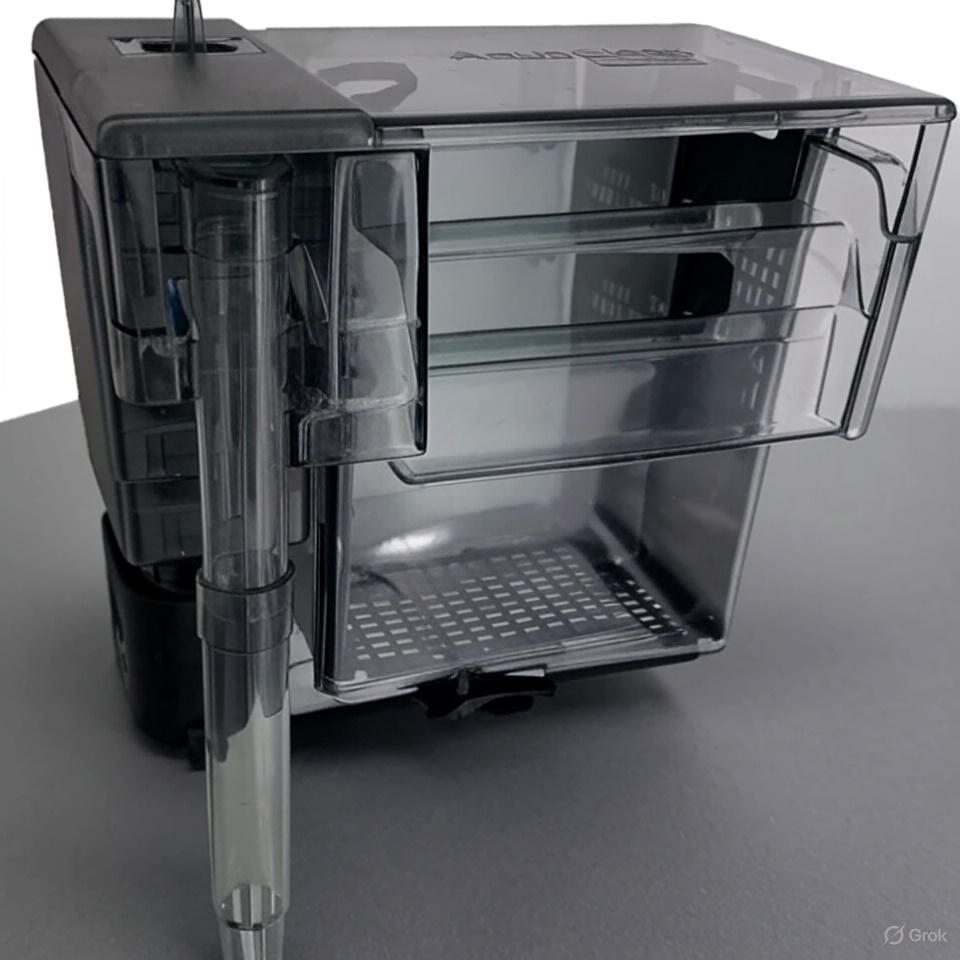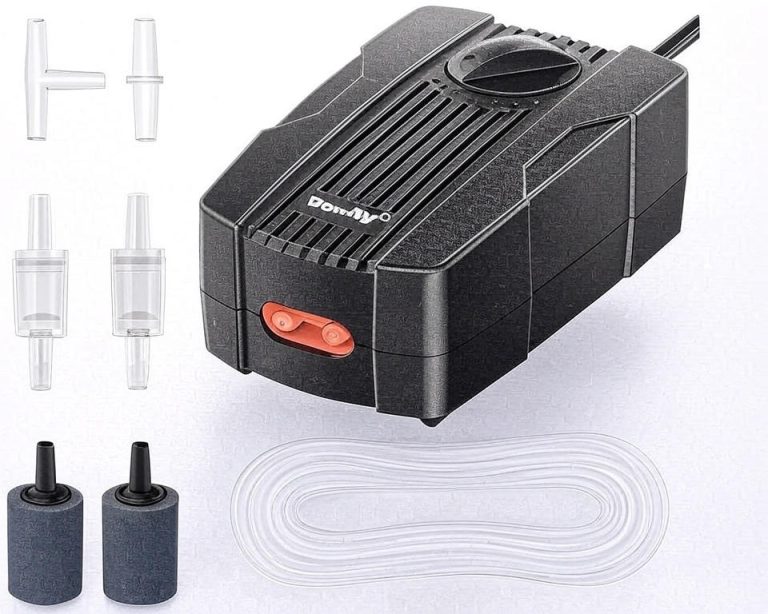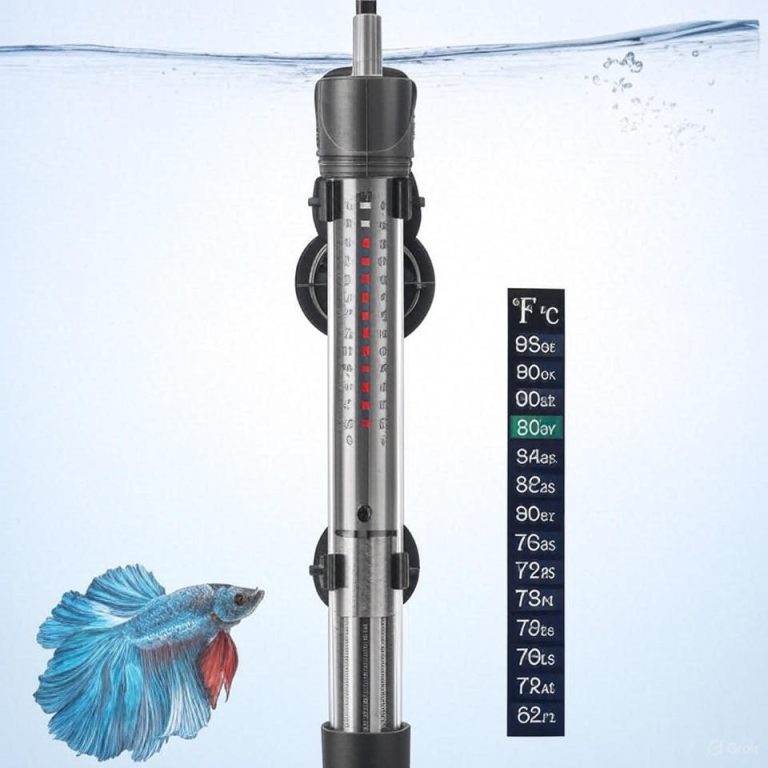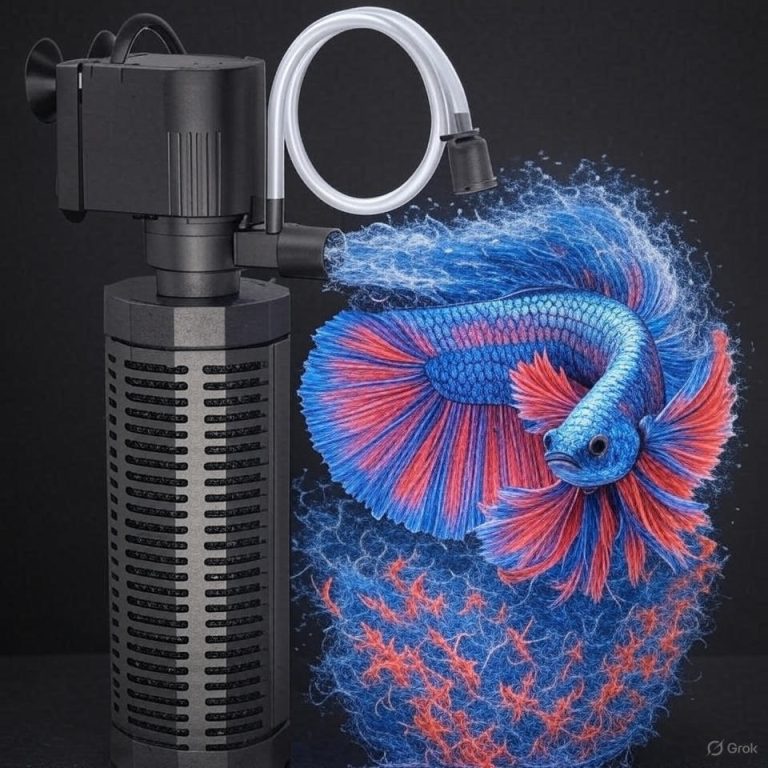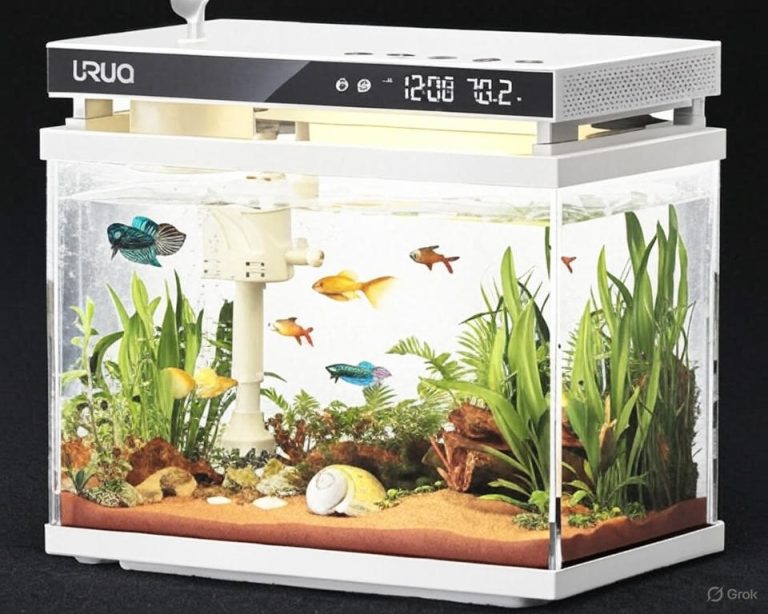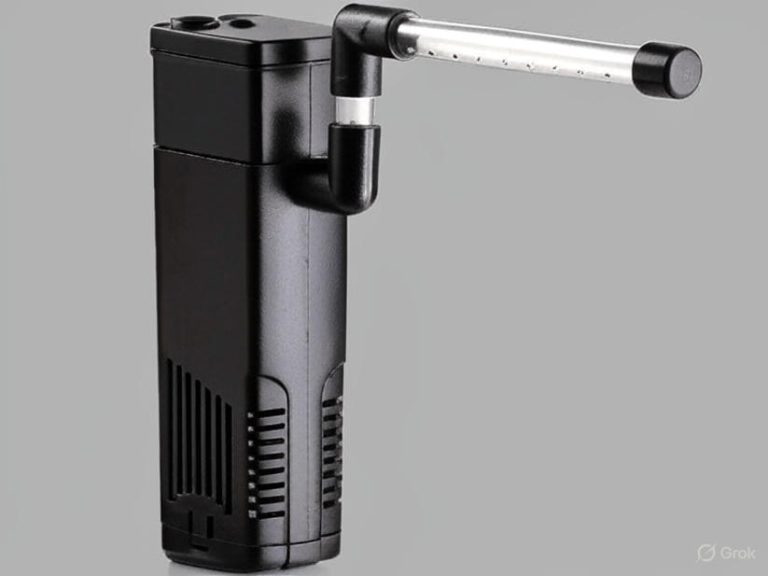5 Best 30 Gallon Aquarium Filter In 2025
Maintaining pristine water quality in your 30-gallon aquarium demands the right filtration system. Clean water serves as the foundation for healthy fish, vibrant plants, and a thriving aquatic ecosystem. The wrong filter can lead to cloudy water, sick fish, and endless maintenance headaches.
This comprehensive review examines five top-performing aquarium filters designed for 30-gallon tanks. Each filter offers unique advantages, from powerful biological filtration to ultra-quiet operation. Our detailed analysis helps you make an informed decision based on your specific aquarium needs.
Why Proper Filtration Matters for Your 30-Gallon Tank
Aquarium filtration removes harmful substances while maintaining beneficial bacteria colonies. A quality filter performs three essential functions: mechanical filtration traps debris, biological filtration processes ammonia and nitrites, and chemical filtration removes dissolved impurities.
Fish produce waste continuously, creating toxic ammonia that can quickly overwhelm a tank ecosystem. Without adequate filtration, ammonia levels spike, leading to fish stress, illness, and death. The nitrogen cycle depends on beneficial bacteria that convert harmful ammonia into less toxic compounds.
Proper water circulation prevents dead spots where waste accumulates. Stagnant water zones become breeding grounds for harmful bacteria and algae. A well-designed filter creates gentle currents that distribute nutrients evenly throughout the tank.
Tank size directly impacts filtration requirements. A 30-gallon aquarium contains more water volume than smaller tanks, requiring filters with higher flow rates and larger media capacity. The bioload from fish, plants, and decorations determines how much filtration power you need.
Top 5 Best Filters for 30-Gallon Aquariums
1. Marineland Penguin Bio-Wheel Power Filter 150 GPH
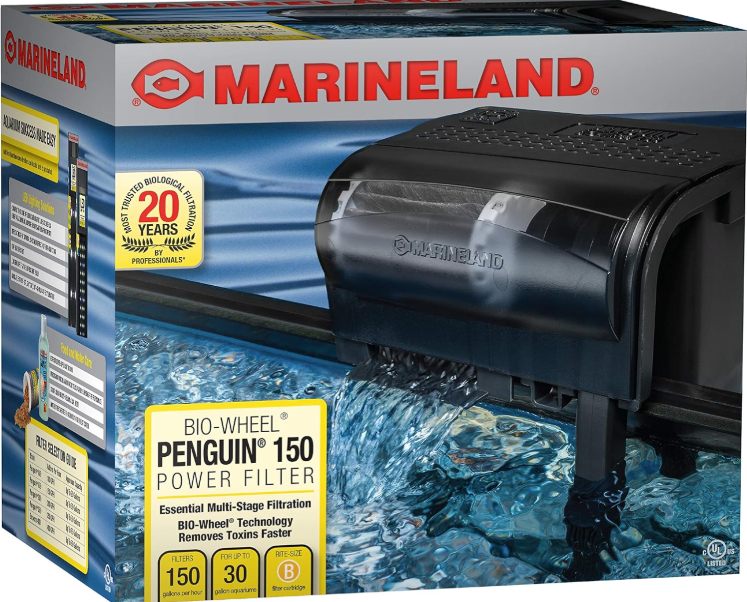
The Marineland Penguin Bio-Wheel Power Filter delivers reliable hang-on-back filtration with innovative bio-wheel technology. This external filter handles 20-30 gallon aquariums with a flow rate of 150 gallons per hour.
Key Features:
- Rotating bio-wheel provides maximum biological filtration
- Two-stage filtration system with replaceable cartridges
- Adjustable mid-level intake reduces noise
- Easy-to-replace filter cartridges
- Compact design fits most tank configurations
The bio-wheel creates a unique environment for beneficial bacteria colonization. As water flows through the system, the wheel rotates slowly, exposing bacteria to both water and air. This dual exposure maximizes bacterial efficiency in converting harmful ammonia.
Installation requires minimal effort with the adjustable leveling device. The filter hangs securely on tank rims without requiring tools or complicated mounting hardware. Water flows through the intake tube, passes through the filter cartridge, and returns to the tank via the bio-wheel.
Performance Analysis: The 150 GPH flow rate provides adequate turnover for most 30-gallon setups. Water clarity improves noticeably within the first week of operation. The bio-wheel technology creates exceptional biological filtration capacity compared to traditional media-based systems.
Maintenance involves replacing filter cartridges every 2-4 weeks, depending on bioload. The bio-wheel rarely requires cleaning, as beneficial bacteria naturally maintain themselves. Cartridge replacement takes less than five minutes without disrupting tank inhabitants.
Pros:
- Excellent biological filtration capacity
- Quiet operation with adjustable intake
- Simple maintenance routine
- Proven reliability across diverse aquarium setups
- Affordable replacement cartridges
Cons:
- Limited chemical filtration options
- Bio-wheel may stop rotating if clogged
- Cartridge replacement costs add up over time
- Not suitable for heavily planted tanks requiring CO2
2. AquaClear 50 Power Filter
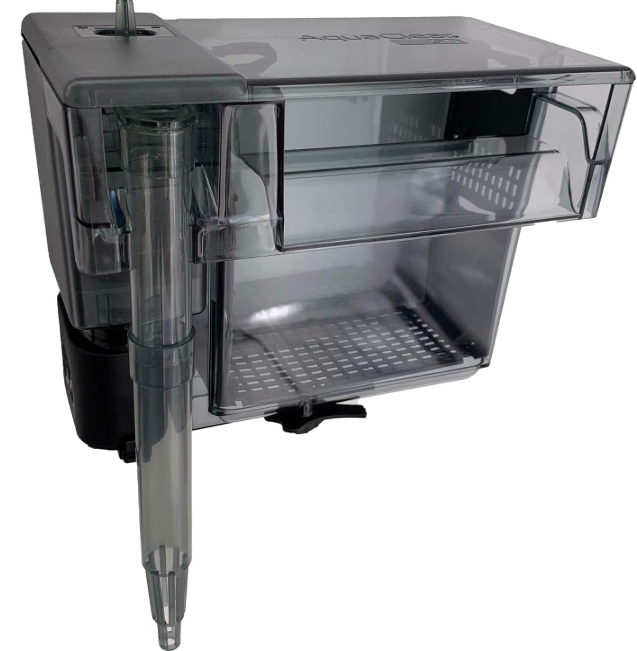
The AquaClear 50 Power Filter stands out with its multi-stage filtration system and customizable media options. This hang-on-back filter accommodates 20-50 gallon aquariums with impressive filtration flexibility.
Key Features:
- Three separate media baskets for customization
- 200 GPH flow rate with adjustable control
- Comes with foam, carbon, and BioMax media
- Re-filtration system maximizes contact time
- Patented impeller design ensures quiet operation
The three-stage filtration system allows complete customization based on your tank’s specific needs. Mechanical filtration occurs first with washable foam blocks, followed by chemical filtration through activated carbon, and finally biological filtration via ceramic rings.
Installation takes minutes with the secure clamp system. The filter sits firmly on tank rims while the adjustable flow control lets you fine-tune water circulation. The re-filtration feature ensures water passes through media multiple times before returning to the tank.
Performance Analysis: The 200 GPH flow rate provides excellent water turnover for 30-gallon tanks. Adjustable flow control accommodates sensitive fish species that prefer gentler currents. The large media capacity handles substantial bioloads without frequent maintenance.
Water quality improvements become apparent within days of installation. The combination of mechanical, chemical, and biological filtration creates crystal-clear water conditions. The washable foam media reduces ongoing operating costs significantly.
Media Customization Options: Replace activated carbon with specialized chemical media like Purigen or phosphate removers. Add extra biological media for heavily stocked tanks or substitute peat for soft-water fish species. The flexible system adapts to changing aquarium requirements.
Pros:
- Highly customizable media options
- Excellent flow rate with adjustment control
- Washable mechanical media saves money
- Superior build quality and durability
- Suitable for diverse aquarium types
Cons:
- Higher initial cost than basic filters
- Requires more complex maintenance routine
- Media baskets may be confusing for beginners
- Takes up more space behind the tank
3. Tetra Whisper Internal Filter
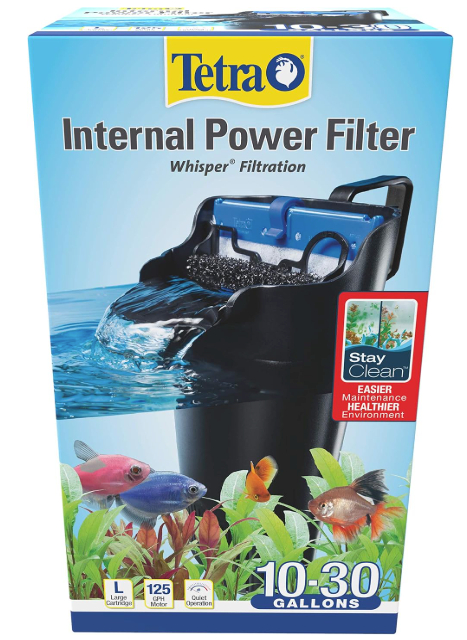
The Tetra Whisper Internal Filter provides in-tank filtration with integrated air pump functionality. This submersible filter handles 10-30 gallon aquariums while adding beneficial oxygenation.
Key Features:
- Complete submersible design
- Built-in air pump creates bubbles
- Dense foam filtration media
- Suction cup mounting system
- Ultra-quiet operation
The internal design eliminates the need for hang-on-back mounting, making it ideal for tanks with limited space or unconventional shapes. The integrated air pump creates a stream of bubbles that enhance oxygen levels while providing visual appeal.
Installation involves securing the filter to the tank wall using heavy-duty suction cups. The power cord exits through the tank lid, requiring a small opening or notch. Water enters through intake slots and passes through dense foam media before returning to the tank.
Performance Analysis: The foam media provides excellent mechanical and biological filtration for smaller bioloads. The integrated air pump creates additional water movement and oxygenation without requiring separate equipment. Operation remains virtually silent, making it suitable for bedroom aquariums.
Maintenance requires rinsing the foam media in tank water every 2-3 weeks. The media rarely needs complete replacement, reducing ongoing costs. The air pump mechanism requires occasional cleaning to maintain optimal bubble production.
Pros:
- Space-saving internal design
- Integrated air pump adds oxygenation
- Extremely quiet operation
- Low maintenance requirements
- Affordable initial cost and operation
Cons:
- Limited filtration capacity for heavy bioloads
- Takes up internal tank space
- Foam media may clog quickly in dirty tanks
- Not suitable for large or aggressive fish
- Air bubbles may disturb some fish species
4. Dual-Chamber U-V Aquarium Filter
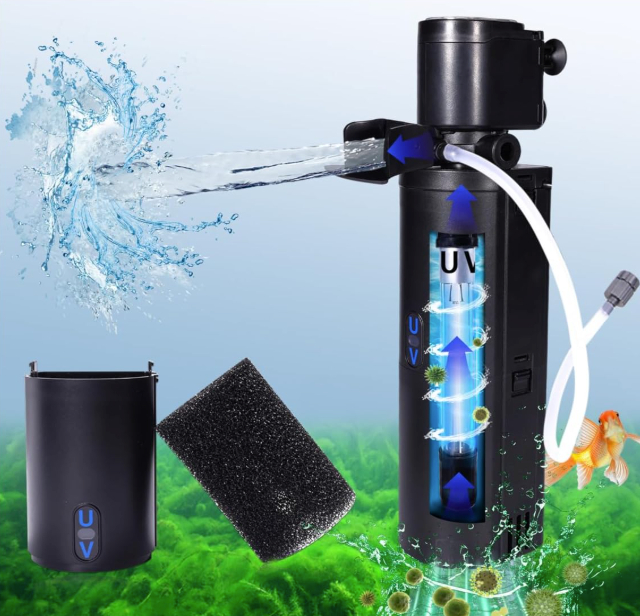
The Dual-Chamber U-V Aquarium Filter offers advanced 4-in-1 functionality with UV sterilization technology. This submersible filter handles 20-75 gallon tanks while providing filtration, wave making, and oxygenation.
Key Features:
- Dual-chamber design with UV sterilization
- 4-in-1 functionality: filtration, UV, waves, oxygen
- Ultra-silent green operation
- Suitable for turtle tanks and fish aquariums
- Multiple media compartments
The UV sterilization component eliminates harmful bacteria, parasites, and algae spores that pass through the filter. This technology creates exceptionally clear water while reducing disease risks for tank inhabitants. The dual-chamber design maximizes media contact time.
Installation requires positioning the filter in a corner or along the tank wall using suction cups. The UV lamp connects to the main filter housing through waterproof connections. Multiple outlet options create varied water flow patterns throughout the tank.
Performance Analysis: The UV sterilization provides unmatched water clarity compared to conventional filters. Green water problems disappear within days of installation. The wave-making function creates natural currents that benefit both fish and plants.
The multiple media chambers accommodate various filtration types simultaneously. Mechanical, biological, and chemical filtration work together with UV sterilization for comprehensive water treatment. The system handles heavy bioloads effectively.
Pros:
- Advanced UV sterilization technology
- 4-in-1 functionality saves space and money
- Excellent for turtle tanks and messy fish
- Ultra-silent operation
- Superior water clarity results
Cons:
- Higher initial investment cost
- UV lamp requires periodic replacement
- Complex installation compared to basic filters
- May be overpowered for delicate aquarium setups
- Requires regular cleaning of UV chamber
5. AquaMiracle Aquarium Filter

The AquaMiracle Aquarium Filter delivers 3-stage internal filtration with dual water outlets and integrated aeration. This submersible filter accommodates 10-40 gallon tanks with versatile functionality.
Key Features:
- 3-stage internal filtration system
- Dual water outlet design
- Integrated aeration function
- Suitable for fish and turtle tanks
- Compact submersible housing
The 3-stage filtration system processes water through mechanical, biological, and chemical media in sequence. The dual water outlets create varied flow patterns that prevent dead spots while distributing clean water evenly throughout the tank.
Installation involves securing the filter inside the tank using adjustable suction cups. The aeration system connects to the main filter through integrated tubing. Multiple outlet positions allow customization of water flow direction and intensity.
Performance Analysis: The compact design delivers impressive filtration capacity relative to its size. The 3-stage system handles moderate bioloads effectively while maintaining quiet operation. The dual outlets create beneficial water circulation patterns.
Maintenance involves cleaning or replacing the three media types on different schedules. The mechanical foam requires weekly rinsing, while biological and chemical media last several weeks. The aeration system needs periodic cleaning to maintain air flow.
Media Configuration: The mechanical stage uses washable foam blocks that trap debris and particles. The biological stage employs ceramic rings that house beneficial bacteria colonies. The chemical stage utilizes activated carbon to remove dissolved impurities and odors.
Pros:
- Comprehensive 3-stage filtration
- Dual outlets improve water circulation
- Integrated aeration saves space
- Suitable for diverse aquarium types
- Reasonable cost for features provided
Cons:
- Limited capacity for heavily stocked tanks
- Internal placement reduces swimming space
- Media replacement can be costly
- Complex maintenance routine
- May create too much current for some fish
Filtration Technology Comparison
Biological Filtration Methods
Biological filtration relies on beneficial bacteria that convert toxic ammonia into less harmful compounds. Different filter designs create varying environments for bacterial colonization. The bio-wheel technology in the Marineland Penguin maximizes bacterial exposure to both water and air.
Ceramic media provides excellent surfaces for bacterial growth with its porous structure. The AquaClear 50’s BioMax ceramic rings offer tremendous surface area in a compact form. Internal filters like the AquaMiracle use ceramic rings in dedicated biological chambers.
Foam media serves dual purposes as mechanical and biological filtration. The open-cell structure traps debris while providing bacterial colonization sites. The Tetra Whisper’s dense foam creates substantial biological capacity despite its simple design.
Mechanical Filtration Approaches
Mechanical filtration removes visible particles and debris from aquarium water. Different media types capture particles of varying sizes. Foam blocks provide coarse filtration while fiber pads capture finer particles.
Multi-stage mechanical filtration uses progressively finer media to trap different particle sizes. The AquaClear 50’s foam blocks remove large debris first, allowing finer filtration media to work more effectively. This approach extends media life and improves efficiency.
Internal filters rely primarily on foam media for mechanical filtration. The Tetra Whisper and AquaMiracle filters use dense foam blocks that require regular cleaning. The foam’s effectiveness depends on proper maintenance schedules.
Chemical Filtration Options
Chemical filtration removes dissolved impurities that mechanical and biological filtration cannot address. Activated carbon represents the most common chemical media, removing odors, discoloration, and some toxins.
Specialized chemical media target specific water chemistry issues. Purigen removes organic compounds, while phosphate removers control algae-promoting nutrients. The AquaClear 50’s customizable media baskets accommodate various chemical filtration options.
UV sterilization provides advanced chemical-free water treatment. The Dual-Chamber U-V filter’s UV lamp destroys harmful microorganisms without affecting beneficial bacteria colonies. This technology creates exceptionally clear water conditions.
Installation and Setup Guidelines
Hang-On-Back Filter Installation
Hang-on-back filters require secure mounting on tank rims with adequate clearance behind the aquarium. The Marineland Penguin and AquaClear 50 both use adjustable mounting systems that accommodate various tank designs.
Prime the filter system before initial startup by filling the media chamber with tank water. This prevents air bubbles that can damage the impeller or reduce flow rates. Most hang-on-back filters include priming instructions with the packaging.
Adjust the intake tube depth to prevent surface agitation or substrate disturbance. The ideal position draws water from mid-tank levels where dissolved waste concentrations are highest. Avoid placing the intake too close to decorations or plants.
Internal Filter Placement
Internal filters require strategic positioning to maximize effectiveness while minimizing visual impact. Corner placement typically provides the best balance of filtration efficiency and aesthetic appeal. Avoid areas with high fish traffic or feeding zones.
Secure internal filters using heavy-duty suction cups rated for the filter’s weight and water pressure. Position the filter where falling off won’t damage tank inhabitants or decorations. Test suction cup adhesion regularly to prevent accidents.
Route power cords through tank lids or designated openings to maintain a clean appearance. Avoid sharp edges that might damage cord insulation. Use cord protectors where necessary to prevent electrical hazards.
UV Filter Considerations
UV filters require proper positioning to ensure effective sterilization without harming beneficial bacteria. Install UV units after biological filtration to avoid killing newly established bacterial colonies. The Dual-Chamber U-V filter integrates UV sterilization appropriately.
UV lamp positioning affects sterilization efficiency significantly. Water must have adequate contact time with UV rays to achieve sterilization. Follow manufacturer guidelines for flow rates and positioning requirements.
Replace UV lamps according to manufacturer schedules, even if they still produce visible light. UV output degrades over time, reducing sterilization effectiveness. Mark replacement dates on calendars to maintain optimal performance.
Maintenance Requirements and Schedules
Routine Cleaning Procedures
Establish regular maintenance schedules based on your aquarium’s bioload and filter type. Lightly stocked tanks may require cleaning every 3-4 weeks, while heavily stocked setups need weekly attention. Monitor water quality parameters to adjust maintenance frequency.
Clean mechanical media in used tank water to preserve beneficial bacteria colonies. Tap water’s chlorine content kills bacteria, disrupting the nitrogen cycle. Use a dedicated aquarium bucket for filter maintenance to avoid contamination.
Rotate cleaning schedules for different media types to maintain continuous biological filtration. Clean mechanical media weekly, rinse biological media monthly, and replace chemical media according to manufacturer recommendations.
Media Replacement Guidelines
Replace mechanical media when cleaning no longer restores effectiveness. Foam blocks typically last 6-12 months with proper care. Fiber pads may require replacement every 2-4 weeks depending on tank conditions.
Biological media rarely requires complete replacement if properly maintained. Ceramic rings and bio-balls can last for several periods with occasional rinsing. Replace biological media only when physically deteriorated or contaminated.
Chemical media effectiveness varies by type and tank conditions. Activated carbon typically lasts 2-4 weeks, while specialized media like Purigen may last several months. Monitor water parameters to determine replacement timing.
Troubleshooting Common Issues
Reduced flow rates often indicate clogged impellers or media. Disassemble the filter according to manufacturer instructions and clean all components thoroughly. Check for debris in impeller chambers and intake tubes.
Excessive noise usually results from air bubbles in the system or worn impeller components. Re-prime the filter to eliminate air bubbles. Replace impeller assemblies if cleaning doesn’t resolve noise issues.
Bio-wheel stoppage in the Marineland Penguin typically indicates biological buildup or debris obstruction. Gently clean the bio-wheel without disrupting beneficial bacteria colonies. Avoid harsh chemicals or excessive scrubbing.
Flow Rate and Tank Turnover Calculations
Determining Proper Flow Rates
Calculate minimum flow rates using the 4-6 times tank volume per hour rule. A 30-gallon tank requires 120-180 gallons per hour minimum flow rate. Heavily stocked tanks may need higher turnover rates for adequate filtration.
Consider fish species preferences when selecting flow rates. Betta fish and other labyrinth species prefer gentle currents, while African cichlids thrive in stronger flows. The AquaClear 50’s adjustable flow control accommodates various species requirements.
Account for media resistance when calculating actual flow rates. New filters typically achieve rated flow rates, but media buildup reduces flow over time. Regular maintenance maintains optimal flow performance.
Bioload Impact on Filtration
Heavy bioloads require increased filtration capacity beyond basic turnover calculations. Large fish, overfeeding, and overstocking create substantial waste loads that overwhelm undersized filters. Calculate bioload based on adult fish sizes and feeding requirements.
Multiple small filters often outperform single large units for heavy bioloads. The combined surface area and varied flow patterns provide superior waste processing. Consider dual filter setups for heavily stocked 30-gallon tanks.
Live plants reduce bioload by consuming fish waste products as nutrients. Heavily planted tanks may require less mechanical filtration but benefit from increased water circulation. Balance filtration needs with plant requirements for optimal results.
Noise Levels and Quiet Operation
Comparing Filter Noise Levels
Most modern aquarium filters operate quietly enough for bedroom placement. The Tetra Whisper lives up to its name with virtually silent operation. The AquaClear 50’s impeller design minimizes noise while maintaining strong flow rates.
Water level affects noise production in hang-on-back filters. Low water levels increase noise as water drops farther into the tank. Maintain proper water levels to minimize operational noise.
Air bubbles in the system create gurgling or rattling sounds. Proper priming eliminates most noise issues. Regular maintenance prevents air bubble accumulation that increases noise over time.
Noise Reduction Techniques
Position filters away from bedroom walls to minimize vibration transmission. Use aquarium mats or foam padding under tanks to absorb vibrations. These simple modifications significantly reduce perceived noise levels.
Clean impeller assemblies regularly to prevent noise from debris or wear. Lubricate impeller shafts according to manufacturer recommendations. Replace worn impeller components before they create excessive noise.
Adjust water flow rates to minimize turbulence noise. Excessive flow creates unnecessary water agitation and noise. Find the optimal balance between filtration effectiveness and quiet operation.
Cost Analysis and Value Comparison
Initial Investment Costs
Entry-level filters like the Tetra Whisper provide basic filtration at minimal cost. These filters suit budget-conscious aquarists with lightly stocked tanks. However, limited capacity may require upgrades as bioloads increase.
Mid-range filters like the Marineland Penguin and AquaClear 50 offer excellent value for most 30-gallon setups. The initial investment pays dividends through reliable performance and reasonable maintenance costs.
Premium filters like the Dual-Chamber U-V command higher prices but provide advanced features like UV sterilization. These filters suit dedicated aquarists seeking maximum water quality and willing to invest accordingly.
Operating Cost Considerations
Calculate ongoing media replacement costs when comparing filters. Washable media reduces operating expenses significantly. The AquaClear 50’s reusable foam saves money compared to disposable cartridge systems.
Electricity consumption varies among filter types but represents a minor ongoing cost. Energy-efficient motors in modern filters minimize electrical expenses. UV filters consume additional power for lamp operation.
Factor in replacement part availability and pricing. Common filters have readily available, competitively priced replacement parts. Specialty filters may require expensive or hard-to-find components.
Long-Term Value Assessment
Quality filters provide reliable service for multiple periods with proper maintenance. The initial investment amortizes over the filter’s lifespan, making premium options more cost-effective long-term.
Consider upgrade potential when evaluating filter value. Modular systems like the AquaClear 50 adapt to changing needs through media customization. Fixed-design filters may require complete replacement as requirements change.
Warranty coverage indicates manufacturer confidence in product quality. Longer warranties suggest superior build quality and reliability. Factor warranty terms into value calculations for long-term ownership.
Species-Specific Filter Recommendations
Freshwater Community Tanks
Community tanks with mixed species benefit from gentle, consistent filtration. The AquaClear 50’s adjustable flow accommodates diverse species preferences while providing excellent water quality. The multiple media stages handle varied bioloads effectively.
Avoid excessive current that stresses slow-moving fish like bettas or angelfish. Internal filters like the Tetra Whisper provide gentle filtration without overwhelming delicate species. Position filters to create varied flow zones throughout the tank.
Consider planted tank requirements when selecting community tank filters. CO2 systems require minimal surface agitation to prevent gas loss. The AquaMiracle’s adjustable outlets allow customization for planted setups.
Goldfish and Large Fish Setups
Goldfish produce substantial waste requiring robust filtration systems. The Marineland Penguin’s bio-wheel technology excels at processing heavy bioloads. The 150 GPH flow rate provides adequate turnover for moderately stocked goldfish tanks.
Large fish benefit from strong water circulation that prevents waste accumulation. The AquaClear 50’s 200 GPH flow rate creates beneficial currents for active species. Multiple media stages handle the increased waste production effectively.
Consider canister filter upgrades for heavily stocked large fish tanks. While the reviewed filters handle moderate bioloads, extreme stocking levels may require additional filtration capacity beyond hang-on-back capabilities.
Turtle Tank Applications
Turtle tanks require specialized filtration due to high waste production and unique water conditions. The Dual-Chamber U-V filter specifically targets turtle tank requirements with UV sterilization and robust filtration capacity.
Turtles create substantial debris requiring frequent mechanical filtration cleaning. The AquaMiracle’s 3-stage system handles turtle waste effectively with proper maintenance. Internal placement protects filters from curious turtles.
UV sterilization provides crucial disease prevention in turtle tanks where bacterial infections spread rapidly. The dual-chamber design ensures adequate contact time for effective sterilization while maintaining beneficial bacteria colonies.
Environmental Impact and Energy Efficiency
Power Consumption Analysis
Modern aquarium filters consume minimal electricity compared to heating and lighting systems. Most filters reviewed operate on 5-15 watts, costing less than $20 annually in electricity. Energy-efficient motors maximize filtration per watt consumed.
UV filters require additional power for lamp operation, typically adding 10-25 watts to consumption. The Dual-Chamber U-V filter’s advanced sterilization justifies the increased power usage through superior water quality and reduced medication needs.
Timer controls can reduce filter power consumption during low-activity periods. However, continuous operation maintains stable biological filtration and prevents harmful bacteria growth. Balance energy savings with filteration requirements carefully.
Sustainable Operation Practices
Washable media reduces environmental impact by eliminating disposable cartridge waste. The AquaClear 50’s reusable foam blocks and ceramic rings minimize landfill contributions while reducing operating costs.
Proper maintenance extends filter lifespan, reducing replacement frequency and associated environmental costs. Quality filters like those reviewed can operate reliably for multiple periods with appropriate care.
Energy-efficient operation includes proper sizing to avoid oversized filters that waste electricity. The reviewed filters match 30-gallon tank requirements efficiently without excessive power consumption.
Making Your Final Filter Decision
Matching Filters to Tank Requirements
Assess your specific tank conditions before making a filter selection. Lightly stocked community tanks thrive with basic filtration like the Tetra Whisper. Heavily stocked or messy fish require robust systems like the AquaClear 50.
Consider future expansion plans when selecting filters. Modular systems accommodate changing needs through media upgrades or additional units. Fixed-capacity filters may require complete replacement as bioloads increase.
Budget constraints influence filter selection but shouldn’t compromise essential filtration requirements. The Marineland Penguin provides excellent value for most 30-gallon applications. Invest in adequate filtration to prevent costly fish losses.
Installation Space Considerations
Available space behind or inside your tank determines filter type suitability. Hang-on-back filters require clearance behind the tank and sturdy rim support. Internal filters consume swimming space but accommodate space-limited installations.
Electrical outlet proximity affects installation feasibility and safety. Plan power cord routing to avoid water contact and maintain clean appearances. GFCI protection is essential for all aquarium electrical equipment.
Maintenance access influences long-term ownership satisfaction. Filters positioned in tight spaces become maintenance burdens. Ensure adequate access for routine cleaning and media replacement procedures.
Conclusion and Top Recommendations
After comprehensive analysis of these five excellent aquarium filters, each offers distinct advantages for 30-gallon tank applications. The AquaClear 50 Power Filter emerges as the top overall choice, combining superior filtration capacity, media customization options, and excellent build quality.
For budget-conscious aquarists, the Marineland Penguin Bio-Wheel provides reliable biological filtration with innovative bio-wheel technology. The proven design delivers consistent performance at an affordable price point with reasonable maintenance requirements.
Space-constrained installations benefit from the Tetra Whisper Internal Filter’s compact design and ultra-quiet operation. The integrated air pump adds value while maintaining minimal space requirements and operating costs.
Advanced aquarists seeking maximum water quality should consider the Dual-Chamber U-V Aquarium Filter’s UV sterilization technology. The 4-in-1 functionality provides comprehensive water treatment for demanding applications like turtle tanks.
The AquaMiracle Aquarium Filter offers solid mid-range performance with 3-stage filtration and dual outlets. The versatile design accommodates various tank types while providing reliable filtration at reasonable cost.
Success with any filter depends on proper installation, regular maintenance, and appropriate sizing for your specific bioload. Monitor water parameters regularly and adjust maintenance schedules based on actual tank conditions rather than generic recommendations.
Invest in quality filtration as the foundation of aquarium success. Clean water supports healthy fish, vibrant plants, and reduced maintenance requirements. The filters reviewed here provide proven performance for 30-gallon aquarium applications with proper care and maintenance.
Remember that filtration systems work best as part of comprehensive aquarium management including appropriate stocking levels, regular water changes, and proper feeding practices. No filter can compensate for poor aquarium husbandry, but the right filter makes good practices more effective and enjoyable.

